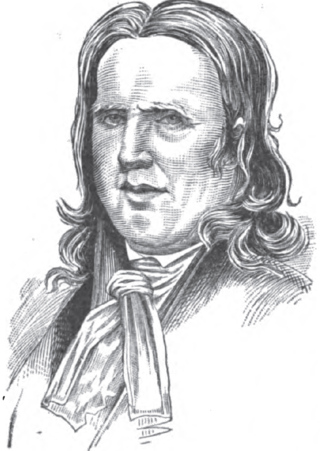Related Research Articles

John Cleves Symmes was a delegate to the Continental Congress from New Jersey, and later a pioneer in the Northwest Territory. He was also the father-in-law of President William Henry Harrison and, thereby, the great-grandfather of President Benjamin Harrison.

Thomas Corwin, also known as Tom Corwin, The Wagon Boy, and Black Tom was a politician from the state of Ohio. He represented Ohio in both houses of Congress and served as the 15th governor of Ohio and the 20th Secretary of the Treasury. After affiliating with the Whig Party, he joined the Republican Party in the 1850s. Corwin is best known for his sponsorship of the proposed Corwin Amendment, which was presented in an unsuccessful attempt to avoid the oncoming American Civil War.

Jeremiah Morrow was a Democratic-Republican Party politician from Ohio. He served as the ninth governor of Ohio, and was the last Democratic-Republican to hold that office. He also served as a United States Senator and a member of the United States House of Representatives from Ohio. He also served in the Ohio Senate.

Ethan Allen Brown was a Democratic-Republican politician. He served as the seventh governor of Ohio.

Thomas Kirker was a Democratic-Republican politician from Ohio. He served as the second governor of Ohio.
The following table indicates the party of elected officials in the U.S. state of Ohio:

Daniel C. Cooper was an American surveyor, farmer, miller and political leader.

John Quincy Smith was an American farmer, politician and legislator from Ohio. He served in the United States House of Representatives for one term from 1873 to 1875, as well as commissioner of Indian Affairs from 1875 through 1877. Prior to this, he served in both the Ohio Senate and Ohio House of Representatives.
William McMillan was a lawyer, Judge, County Commissioner, and Delegate to the 6th United States Congress from the Northwest Territory. He was among the first settlers of what would become Cincinnati, Ohio.
Edward King was an Ohio legislator and lawyer who was twice Speaker of the Ohio House of Representatives, and was on the first faculty of the Cincinnati Law School.
Daniel Symmes was a politician in the U.S. State of Ohio in the Ohio State Senate, an Ohio Supreme Court Judge 1805–1808, Mayor of Cincinnati 1808–1809, and register of the Cincinnati land office.
James Pritchard was an American Revolutionary War veteran and Democratic-Republican politician who served in the legislatures of the Northwest Territory, and later in Ohio, and was unsuccessful in runs for congress.

William Goforth was an American politician and physician in Ohio and Louisiana. He administered the first smallpox vaccines and conferred the first medical degree in the frontier west, and was a delegate to write the first constitution of Louisiana. He also excavated a large number of megafauna bones at Big Bone Lick in Kentucky.
William Goforth (1731–1807), also called Judge William Goforth and Major William Goforth, was a member of the Committee of One Hundred and Committee of Safety in New York City, an officer of the New York Line during the American Revolutionary War, and was a member of the New York State Assembly after the war. He was one of the earliest immigrants to the Cincinnati area, where he was named a judge and was elected to the territorial legislature.

The First Ohio General Assembly was the initial meeting of the Ohio state legislature, composed of the Ohio State Senate and the Ohio House of Representatives. It convened in Chillicothe, Ohio, on March 1, 1803, and adjourned April 16, 1803. This General Assembly coincided with the first year of Edward Tiffin's first term as Ohio Governor.

The Second Ohio General Assembly was the second meeting of the Ohio state legislature, composed of the Ohio State Senate and the Ohio House of Representatives. It convened in Chillicothe, Ohio, on December 5, 1803, and adjourned February 17, 1804. This General Assembly coincided with the second year of Edward Tiffin's first term as Ohio Governor.

Charles Anthony (1798–1862) was a legislative leader in the U.S. State of Ohio. He was also a Militia General during the Mexican–American War, a Masonic Grand Master for his state, and a U.S. Attorney.
William Cortenus Schenck (1773–1821) was a pioneer surveyor, militia general and legislator. Two of his sons were prominent military men.
Elijah Vance (1801–1871) was a Democratic politician from Butler County, Ohio. He was Speaker of the Ohio Senate in 1835 and 1836.
References
- Morrow, Josiah (1882). The History of Warren County, Ohio. W. H. Beers Co.
- Taylor, William Alexander; Taylor, Aubrey Clarence (1899). Ohio statesmen and annals of progress: from the year 1788 to the year 1900 ... Vol. 1. State of Ohio. p. 145.
- Bell, William Jr. (1876). Annual report of the Secretary of State to the Governor and General Assembly for the year 1875... Ohio Secretary of State.
- Goss, Charles Frederic (1912). Cincinnati, the Queen City, 1788–1912. Vol. 2. Cincinnati: S J Clarke Publishing Company.